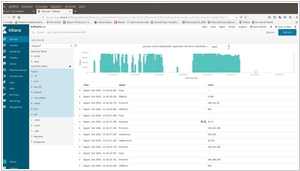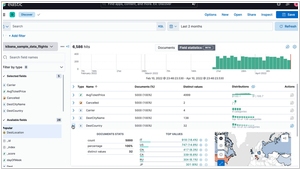ElasticSearch vs Kibana
August 06, 2023 | Author: Michael Stromann
See also:
Top 10 Big Data platforms
Top 10 Big Data platforms
Elasticsearch and Kibana are two powerful components of the Elastic Stack, designed to work together to provide a comprehensive search, analytics, and visualization solution. While they complement each other, they serve distinct purposes and have key differences in their functionalities.
Elasticsearch is a distributed, full-text search engine and NoSQL database. It excels at indexing and querying vast amounts of structured and unstructured data in near real-time. Elasticsearch is optimized for speed and scalability, making it ideal for applications where quick search and retrieval of data are crucial. It is built on top of Apache Lucene and offers advanced features like sharding, replication, and support for complex queries, which enable horizontal scaling and high availability.
On the other hand, Kibana is a web-based data visualization platform designed to work with Elasticsearch. It allows users to interactively explore, analyze, and visualize data stored in Elasticsearch through intuitive and customizable dashboards, charts, and graphs. Kibana makes it easy to create complex visualizations without requiring extensive coding knowledge. Users can create real-time visualizations and set up alerts based on data conditions. Unlike Elasticsearch, Kibana does not handle data storage and retrieval; it relies on Elasticsearch to index and manage the data, focusing solely on data visualization and analysis.
See also: Top 10 Big Data platforms
Elasticsearch is a distributed, full-text search engine and NoSQL database. It excels at indexing and querying vast amounts of structured and unstructured data in near real-time. Elasticsearch is optimized for speed and scalability, making it ideal for applications where quick search and retrieval of data are crucial. It is built on top of Apache Lucene and offers advanced features like sharding, replication, and support for complex queries, which enable horizontal scaling and high availability.
On the other hand, Kibana is a web-based data visualization platform designed to work with Elasticsearch. It allows users to interactively explore, analyze, and visualize data stored in Elasticsearch through intuitive and customizable dashboards, charts, and graphs. Kibana makes it easy to create complex visualizations without requiring extensive coding knowledge. Users can create real-time visualizations and set up alerts based on data conditions. Unlike Elasticsearch, Kibana does not handle data storage and retrieval; it relies on Elasticsearch to index and manage the data, focusing solely on data visualization and analysis.
See also: Top 10 Big Data platforms





